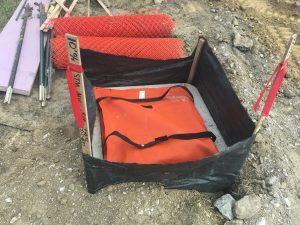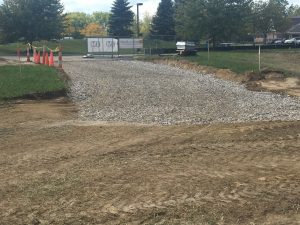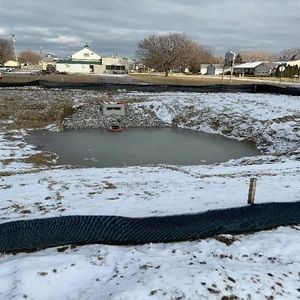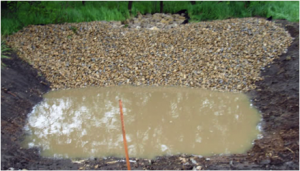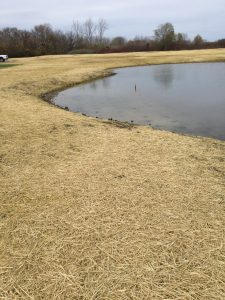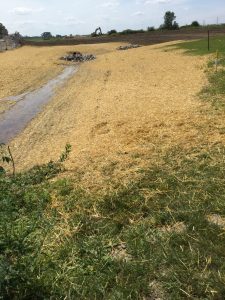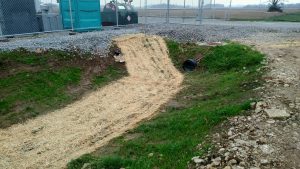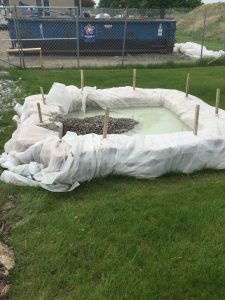STORMWATER SERVICES
Construction sites impact Ohio’s waters by adding pollutants, especially sediment, to rainwater running off of construction sites during construction, and make long-term land use changes that alter the hydrology and pollutant loading of local streams. To limit the negative impacts of construction, Ohio EPA administers a permitting program designed to document construction activity in the state and require practices that keep pollutants out of streams. The permitting program is mandated in the Clean Water Act and is part of the NPDES (National Pollutant Discharge Elimination System) program.
Stormwater Pollution Prevention Plan (SWPPP) Reviews
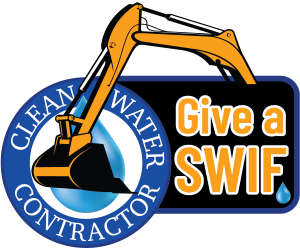
Develop a Storm Water Pollution Prevention Plan (SWP3) for the construction site. Submit the proposed site plans including the SWP3, runoff calculations, and desired BMP specifications to our office and the Erie County Engineer’s Office for review for any site disturbing 1,000 square feet or more. For more information and guidance, check out the Ohio EPA General Construction Permit for Large and Small Construction Sites.
Steps:
1. Submit proposed SWPPP Plan to the necessary community, Erie County Engineer’s Office and Erie Conservation District (if within a Township). All proposed projects within City limits should be initiated with the city directly.
2. Submit fees: our plan review fees reflect the 2024 amounts; could we update those to include 1,000 sq. ft. to 1 acre $300.00, 1 acre to 5 acres $600.00, and greater than 5 acres $1,000.00.
3. Submit notice of intent: Submit a Notice of Intent (NOI) to Ohio EPA requesting coverage for your discharges under the general permit if the disturbance is greater than 1 acre.
4. Wait to receive approval: Wait until you receive approval from the Erie County Engineer’s Office and the Ohio EPA approval letter stating that you are covered under the general permit before commencing work on the site.
5. Proceed with construction: Proceed with construction, including regular maintenance and inspections of sediment and erosion controls and storm water management facilities on site.
6. Submit notice of termination: once you’ve received your final SWPPP Report confirming that final stabilization has been achieved and your temporary controls have been removed from the site, submit the notice of termination (NOT) to Ohio EPA requesting completion of permit coverage. All construction records must be kept for 3 years following the Ohio EPA accepting your NOT application.
Sediment and Erosion Control Inspections
Inspections will occur on any and all construction activities which fall under the Ohio EPA General Construction Permit, and/or the Erie County Storm Water Management Erosion Control Permit. Inspections will focus on temporary or permanent sediment/erosion controls, good housekeeping practices, and the overall effectiveness of preventing sediment from leaving the construction site.
The following sediment and erosion controls are among the most common ones you will see on active construction sites, though these are not the only best management practices (BMPs) that can be used to prevent erosion and stop sediment from leaving the site.
Silt Fencing
Silt fence is a sediment-trapping practice utilizing a geotextile fence, topography and sometimes vegetation to cause sediment deposition. Silt fence is used to prevent sediment-laden sheet runoff from entering into downstream creeks and storm sewers. This practice forces sheet runoff to pond, and facilitates any suspended solids to settle out. Silt fence should follow contours, not property lines.
Silt fence is not the most durable and as a result requires maintenance throughout the construction project. Often times, silt fence is not installed correctly. The biggest challenges in properly installing silt fence that we observe is trenching the geotextile at least 8 inches underground, and seams of sections shall be spliced together at a post with a minimum of 6 inch overlap.
Storm Drain Inlet Protection
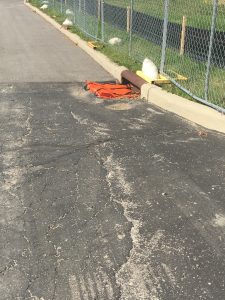
Due to their poor effectiveness, inlet protection on storm drains need continual maintenance during the site’s construction phases, and should always be used in conjunction with other sediment controls.
Construction Entrance
A construction entrance is a stabilized pad of stone underlain with geotextile, used to reduce the amount of mud tracked off-site with construction traffic. Construction entrances should be installed at any points of ingress/egress, and all construction traffic should adhere to using them. Since most of the mud is flung from tires as they reach higher speeds, construction entrances should not be the only practice relied upon to manage off-site tracking.
Common issues observed with installations of construction entrances are the lack of geotextile being applied, incorrect size of stones used, and thickness of stone layer not being sufficient. Construction entrances must be installed first, before any grading activities occur, and should be no less than 70 feet in length. An ODOT #2 stone layer at least 6 inches thick shall be applied over a geotextile layer. The use of geotextile under the stone helps to prevent potholes from developing and will save the amount of stone needed during the life of the practice.
Sediment Basins
Sediment basins are temporary settling ponds that release storm water runoff at a controlled rate. The basin is designed to slowly release runoff, detaining it long enough to allow most of the sediment to settle. The typical components of a sediment basin are the embankment, pool area for water and sediment storage, principal and emergency spillways, and a skimmer.
As with many other sediment controls, sediment basins should be constructed as a first step in any land disturbing activities, and shall remain in good working order until any area contributing runoff is stabilized with dense permanent vegetation. Often times, sediment basins are converted to detention basins for post-construction storm water management.
Sediment Traps
A sediment trap is a temporary settling pond formed by construction of an embankment and/or excavated basin with a simple outlet structure. The outlet structure is typically stabilized with geotextile and rip-rap. The purpose of a sediment trap is to detain sediment-laden storm water runoff, and allow the majority of the sediment to settle out. They are established early in the construction process using natural drainage patterns and favorable topography to minimize grading. Sediment traps are to be used for 5 acres or less of contributing drainage area (Larger areas require a properly constructed sediment basin with controlled outlet structure).
Temporary Soil Stabilization
Temporary seeding or mulching must be applied to exposed soil where additional work (grading, etc.) is not to occur within 14 days to provide temporary soil stabilization. Temporary seeding and/or a protective layer of straw mulch protects bare soils from erosion by shielding it from raindrop impact. The most effective way to avoid using temporary soil stabilization is to phase construction activities. This is achieved by leaving at least half of the site undisturbed, or re-stabilizing areas of the site prior to additional grading operations.
Permanent Seeding and Erosion Control Matting
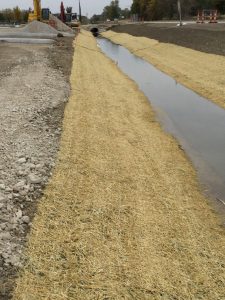
The most common issues we see are the timing of application of seed, and the lack of mulching or erosion control matting used. Permanent seeding includes site prep, seedbed prep, planting, AND mulching. On areas where soils may be easily erodible such as slopes greater than 3:1, it is necessary to use either an erosion control matting, or apply hydraulic seeding with a tackifier.
Erosion control matting is applied after seeding to stabilize the soil while vegetation becomes established. Erosion control matting is also useful in areas where straw mulch is difficult to hold in place due to wind or water, or in areas where the soil is prone to drying. Matting not only prevents erosion, but holds in moisture as well, accelerating seed germination.
Concrete Washout Pits
Concrete trucks are not permitted to wash out directly into storm sewers, streams or drainage channels. Washing into a nearby storm drain is considered to be an illicit discharge. The purpose of installing a concrete washout pit is to collect and retain all the concrete washout water and solids in leak proof containers, so that this caustic material does not reach the soil surface and then migrate to surface waters or into the ground water. The washwater that is retained will evaporate, leaving only hardened cementitious solids which can then be recycled. As with all best management practices (BMPs), regular maintenance is required to ensure effectiveness.


